What is the difference between red and yellow bone marrow?
Safiya Zaloum
Bone marrow is a spongy tissue found in the centre of the large bones in our bodies. It makes all of our blood cells and contains stem cells. Every day our bone marrow produces 200 billion new blood cells! You might have heard of bone marrow, but did you know that there are two types – red and yellow. Both are found inside our bones but they have different functions.
What does red bone marrow do?
Red bone marrow is where red blood cells, white blood cells and platelets are made. It produces all of the red blood cells and platelets, and most of your white blood cells. Red blood cells carry oxygen from our lungs to our organs and muscles, which keeps us alive. There are many types of white blood cells, and these fight infection. Platelets help your blood to clot when you get a cut by clumping together to form a sort of barrier.
Red bone marrow and yellow bone marrow are found on the insides of the long bones, such as your femur, the long bone in your thigh. It is also found in other bones such as the shoulder blades, hips, skull and flat bones, such your ribs.
Red bone marrow contains hematopoietic stem cells which is what all blood cells start off as. Stem cells are sort of like children – they could grow up to do any job. These stem cells are already destined to become blood cells – they are already partially differentiated, meaning they have started down the path to becoming blood cells already and cannot turn back. From here, they can go down many different paths to become many different types of blood cells; red blood cells and any of the many types of white blood cells.
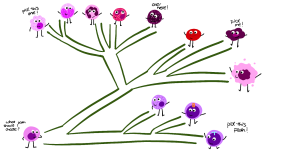
A stem cell before it has differentiated
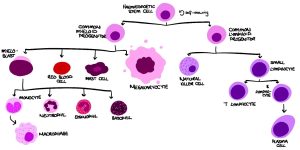
What does yellow bone marrow do?
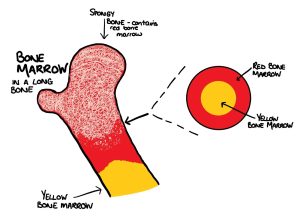 Yellow bone marrow is located in the hollow cavities of the long bones. It is usually found at the centre, surrounded by red bone marrow. We aren’t born with any yellow bone marrow – it starts replacing red bone marrow at about age 7 until about half of the bone marrow is yellow.
Yellow bone marrow is located in the hollow cavities of the long bones. It is usually found at the centre, surrounded by red bone marrow. We aren’t born with any yellow bone marrow – it starts replacing red bone marrow at about age 7 until about half of the bone marrow is yellow.
The main job of yellow bone marrow is to store fat which helps to support the bone in its functioning. Yellow bone marrow also contains mesenchymal stem cells. This type of stem cell can produce fat, cartilage and bone. In life-threatening situations, such as when a person is losing a lot of blood, yellow bone marrow can take on the role of red bone marrow and produce red blood cells.
What is the difference between red and yellow bone marrow?
When we are born, all of our bone marrow is red, with half becoming yellow bone marrow by the age of 7. By learning about red and yellow bone marrow, we can see that they have different jobs, even though they are both located in the long bones. Here is a table summarising the differences between red and yellow bone marrow:
| Red Bone Marrow | Yellow Bone Marrow |
| Found in the long bones and flat bones | Only found in the long bones |
| Produces blood cells | Stores fat |
| Born with red marrow | Develops after birth up to age 7 |
What happens if the bone marrow isn’t working properly?
We need our bone marrow to stay alive. Our blood cells don’t live forever – red blood cells have an average lifespan of just 120 days. We need our bone marrow to keep producing blood cells. If the bone marrow stops working properly and fails, this can lead to a condition called aplastic anaemia. People can also get cancer of the bone marrow or cancer of the blood. Some people with these conditions may need a bone marrow transplant if other treatments have not worked, as we need working bone marrow to produce the blood cells that help keep us alive and our bodies functioning properly.
A bone marrow transplant involves first finding a matching donor – the person who is providing the bone marrow, for the recipient – the person who needs the transplant. Everyone has little markers on their cells but there are different types of these between people. These are called HLA markers and the immune cells in your body use these to recognise which cells are your body cells and which are not, like bacteria and viruses that can make us sick. It is sort of like your school uniform – this tells people that you belong to your school, someone who goes to a different school has a different uniform to show that they belong to their school. These HLA markers need to be the same in the donor and recipient, otherwise the recipient’s immune cells can start attacking the cells from the donor as they don’t recognise these cells are body cells that the recipient needs.
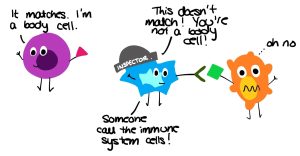
Once a suitable donor is found, stem cells are taken from their bone marrow using a needle to draw them out of the bone marrow in the hip. They are then infused into the recipient through a blood vessel. The recipient has to have chemotherapy before they can receive the transplant, to get rid of all of their damaged blood cells.
